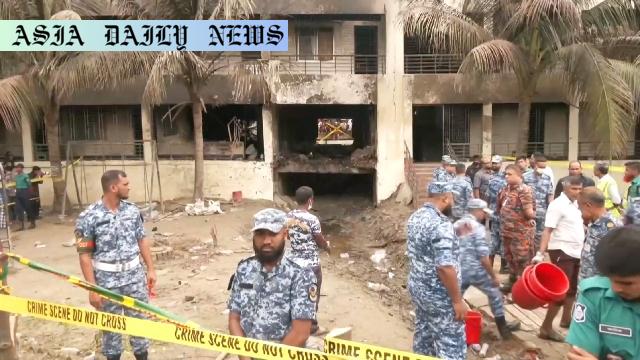Bangladesh Jet Crash: At least 31 dead, injuries reported after fighter jet hits school, prompting protests and demands for accountability.
A Bangladeshi Air Force jet crashed into a school in Dhaka, killing at least 31 people.
Most of the deceased were children under 15, with 80 others injured, many suffering burns.
Protests erupted demanding accountability, as officials cited mechanical failure as the cause.

The Incident and Immediate Aftermath
On Monday, the bustling capital city of Dhaka was rocked by a tragic and unprecedented accident. A Bangladeshi Air Force fighter jet, part of a routine training exercise, crashed into the Milestone School and College. The impact and subsequent flames claimed the lives of at least 31 individuals, with dozens more injured. Tragically, many victims were children under 15, along with the pilot. This heart-wrenching event not only devastated families but left the nation grappling with profound sorrow and questions of accountability.
Protests and Public Outcry
In the aftermath of the crash, a wave of unrest swept through the area as hundreds of grieving and angered students demanded transparency. They sought immediate clarification on the actual number of casualties and held officials accountable for the tragedy. ‘The first thing we want is for the actual number of bodies not to be kept a secret,’ said one distressed student. Parents, too, shared harrowing accounts of their loss, such as Rafiq Molla, who recounted receiving the terrible call about his daughter’s passing.
Investigations and Preliminary Findings
Military officials quickly announced that the accident was a result of mechanical failure. Debris scattered across the school premises indicated a catastrophic breakdown shortly after takeoff. The country’s interim government has pledged a thorough investigation to uncover the exact cause of the crash and to evaluate the safety protocols in place.
Impact on Families and Educational Institutions
The emotional toll on affected families is immeasurable. Losing children in what should have been the safe haven of a classroom is every parent’s nightmare. At the same time, educational institutions are grappling with the unimaginable trauma inflicted on students who witnessed the event and its aftermath. Support structures, including counseling, have been put in place, but the psychological scars might linger for years.
Questions of Accountability and Future Measures
This tragedy reignites critical conversations about aviation safety and accountability, especially in populous urban areas. While the military has insisted on the mechanical nature of the failure, public confidence demands transparency in investigations and a reexamination of safety and training protocols for military exercises. Addressing these concerns will be vital in preventing such catastrophic events in the future.
Conclusion
The Bangladesh jet crash serves as a stark reminder of how fragile life can be and the importance of safety in all operations. As Dhaka grieves, the nation must come together to demand accountability and ensure that a tragedy of this magnitude never recurs. The government’s pledge to investigate and preventive measures will be closely watched by the world, making this a crucial test for the country in both governance and crisis management.



Commentary
Unimaginable Tragedy Strikes Dhaka
The recent fighter jet crash in Dhaka, which claimed 31 lives, most of them children, is a devastating incident that has left the nation in shock. This unimaginable tragedy not only underscores the fragility of life but also raises significant concerns about safety protocols during military training operations. The loss of innocent lives, particularly children who were simply in their classrooms, is an unthinkable pain that no family should endure.
Safety and Accountability—A Growing Concern
This tragic event highlights the dire need for enhanced safety measures in urban areas where military training exercises are conducted. The reported mechanical failure that led to the crash demands a thorough and transparent investigation to uncover the root cause. Moreover, the public outcry and protests near the accident site reflect a growing distrust in the system’s ability to safeguard its most vulnerable citizens.
Supporting the Bereaved and Moving Forward
As the nation mourns, it is crucial for both the government and community to extend support to grieving families. Psychological counseling, financial assistance, and community solidarity will play a vital role in helping them cope with their loss. At the same time, this tragedy presents an opportunity for systemic improvements. Bangladesh must evaluate not only its military protocols but also its urban planning and emergency response mechanisms to prevent future incidents of this nature.
Hope for a Safer Tomorrow
While the wounds of this tragedy may take years to heal, it serves as a wake-up call for all stakeholders involved. Striking a balance between operational training needs and civilian safety is imperative. By addressing these challenges head-on, Bangladesh can honor the lives lost and ensure a safer future for its citizens. This incident, while profoundly tragic, must become a catalyst for meaningful change.